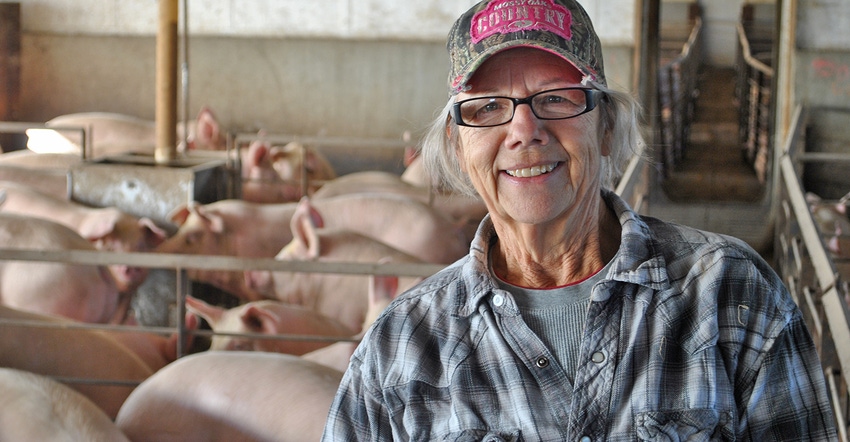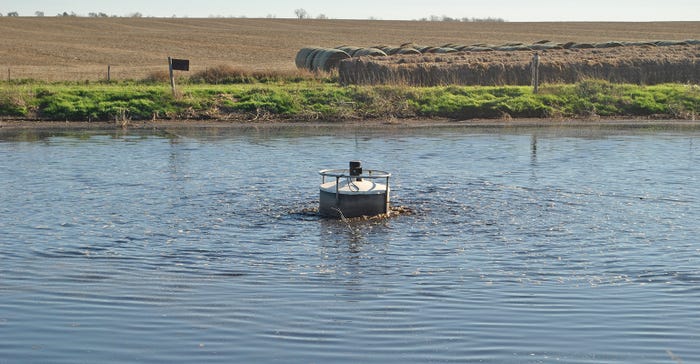
A family-owned swine finishing unit near Parkston, S.D., is utilizing cutting-edge technology to reduce odor from its small manure lagoon. The family also retrofitted a new manure-handling design, installing Flo-Thru Gutters on top of slatted floors in their 600-head 1997 finishing barn to reduce gas, odor and dust and keep their hogs and those tending to the hogs happier and healthier.
Randy and Connie Heitzman wanted to establish a healthier environment in their finishing barns where Connie spends a lot of her workdays. “We also wanted to reduce the odor from the manure-holding lagoon to be good neighbors and to make the lagoon work better in the system for our finishing unit,” says Connie. The way to meet their goals came from a systems approach, and it all started with the lagoon.
 LAGOON FIX: A floating electric-powered circulator from The eXpert Company helps the Heitzman reduce odor emission from the lagoon.
LAGOON FIX: A floating electric-powered circulator from The eXpert Company helps the Heitzman reduce odor emission from the lagoon.

In 2005, the family purchased a floating wind-powered circulator unit from The eXpert Co. for their lagoon, to change the makeup of the lagoon to an aerobic environment. “About 30 to 45 days after installing a unit in the Heitzmans’ lagoon, it became odor-free,” says Kerwin Miller, sales manager for The eXpert Co. “In older lagoons, a backlog of nutrients waits for transformation to odor-free. The resulting lagoon water is not only odor-free, but it is also pathogen-free. What we call ‘safe water’ is crop-ready 99% true liquid fertilizer, suitable to be sprinkled directly onto growing crops with no damage or yellowing of leaves,” he says. “New lagoons with Circul-O2-Rater units are odor-free immediately.”
While the Heitzmans do not currently utilize their lagoon water for fertigation through a pivot, Connie says that they have looked into the idea for the future.
The wind-powered unit was replaced in 2010 with an electric Circul-O2-Rater unit to provide 24-hour continuous circulation, Miller explains. “We learned that wind power is not appropriate for manure lagoons because intermittent wind results in loss of manure nitrogen when the wind doesn’t blow,” he says.
“The first consideration for producers to think about with the Circul-O2-Rater is whether the lagoon is large enough for aerobic treatment,” Miller says. “Most are. Each unit has the capability of processing manure from 100 animal units or about 600 finisher pigs on a daily basis, and this is scalable to any sized barn.”
In 2008, Heitzmans remodeled their traditional slatted floor, shallow pit hog finishing barn by installing a Flo-Thru Gutter flush system that allows pigs to cool themselves by wallowing in the flushing water from the lagoon as it removes manure from the barn floor. “This type of system has been around for over 40 years,” Miller says. “It was designed in the 1970s in Wisconsin by T.J. Tooley, an agriculture systems engineer. The system recycles safe water from an odorless lagoon to remove manure, including odor and gas, from the barn on a continuous basis,” he notes. “Pigs are healthier and go to market sooner in an odor- and gas-free environment. In addition, they use less feed.”
 FLUSH SYSTEM: Pigs wallow in the flushing water from the lagoon. The recycled water removes manure from the barn floor.
FLUSH SYSTEM: Pigs wallow in the flushing water from the lagoon. The recycled water removes manure from the barn floor.

Connie says that they no longer use soap when washing down the barns. “We don’t need to use antibiotics on the pigs either,” she says. “In adding this system, we really wanted to get away from the gas and odor from manure in the pit beneath the hogs,” she explains. “Since adding the gutters, I don’t know when is the last time we called the veterinarian for the hogs. We just rarely have any health concerns at all, even in the wintertime.” She says that new pigs brought into the barn love to play in the water flowing in the gutters and start standing in the rushing water almost immediately. With the distraction of the gutters, fighting and tail biting is also greatly reduced.
For the Heitzmans, these modifications to their finishing systems made a big difference. “Elimination of barn odor, gas and disease pathogens are the way gains are made and certainly improve the quality of life for farmers and their neighbors,” Miller says. “The aerobic Flo-Thru Gutter systems combined with the Circul-O2-Rater unit work in tandem to carry manure out of the barn on a continuous basis, intending to eliminate odor and gas from the livestock environment and the neighborhood.”
For the Heitzmans, the modifications to their finishing unit have been a success story, helping them to meet their goals. Connie says that her many hours of working with the hogs in the barn are more enjoyable because of the great reduction in gas, odor and dust.
You can learn more by contacting Miller at 605-770-4332.
About the Author(s)
You May Also Like






